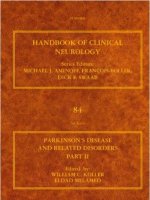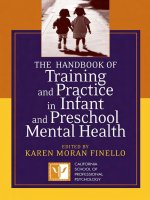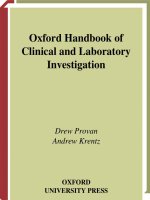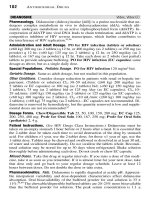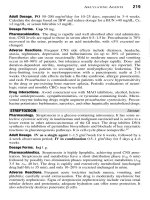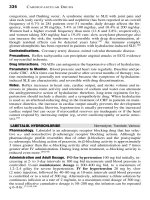Oxford Handbook of Clinical and Laboratory Investigation (4e 2018)
Bạn đang xem bản rút gọn của tài liệu. Xem và tải ngay bản đầy đủ của tài liệu tại đây (12.49 MB, 1,007 trang )
OXFORD MEDICAL PUBLICATIONS
Oxford Handbook of
Clinical and
Laboratory
Investigation
ii
Published and forthcoming Oxford Handbooks
Oxford Handbook for the Foundation
Programme 4e
Oxford Handbook of Acute
Medicine 3e
Oxford Handbook of Anaesthesia 4e
Oxford Handbook of Applied Dental
Sciences
Oxford Handbook of Cardiology 2e
Oxford Handbook of Clinical and
Healthcare Research
Oxford Handbook of Clinical and
Laboratory Investigation 3e
Oxford Handbook of Clinical
Dentistry 6e
Oxford Handbook of Clinical
Diagnosis 3e
Oxford Handbook of Clinical
Examination and Practical Skills 2e
Oxford Handbook of Clinical
Haematology 4e
Oxford Handbook of Clinical
Immunology and Allergy 3e
Oxford Handbook of Clinical Medicine
–Mini Edition 9e
Oxford Handbook of Clinical
Medicine 10e
Oxford Handbook of Clinical Pathology
Oxford Handbook of Clinical
Pharmacy 3e
Oxford Handbook of Clinical
Rehabilitation 2e
Oxford Handbook of Clinical
Specialties 10e
Oxford Handbook of Clinical Surgery 4e
Oxford Handbook of Complementary
Medicine
Oxford Handbook of Critical Care 3e
Oxford Handbook of Dental
Patient Care
Oxford Handbook of Dialysis 4e
Oxford Handbook of Emergency
Medicine 4e
Oxford Handbook of Endocrinology
and Diabetes 3e
Oxford Handbook of ENT and Head
and Neck Surgery 2e
Oxford Handbook of Epidemiology for
Clinicians
Oxford Handbook of Expedition and
Wilderness Medicine 2e
Oxford Handbook of Forensic Medicine
Oxford Handbook of Gastroenterology
& Hepatology 2e
Oxford Handbook of General
Practice 4e
Oxford Handbook of Genetics
Oxford Handbook of Genitourinary
Medicine, HIV, and Sexual Health 2e
Oxford Handbook of Geriatric
Medicine 2e
Oxford Handbook of Infectious
Diseases and Microbiology 2e
Oxford Handbook of Key Clinical
Evidence 2e
Oxford Handbook of Medical
Dermatology 2e
Oxford Handbook of Medical Imaging
Oxford Handbook of Medical
Sciences 2e
Oxford Handbook of Medical Statistics
Oxford Handbook of Neonatology 2e
Oxford Handbook of Nephrology and
Hypertension 2e
Oxford Handbook of Neurology 2e
Oxford Handbook of Nutrition and
Dietetics 2e
Oxford Handbook of Obstetrics and
Gynaecology 3e
Oxford Handbook of Occupational
Health 2e
Oxford Handbook of Oncology 3e
Oxford Handbook of Operative
Surgery 3e
Oxford Handbook of
Ophthalmology 3e
Oxford Handbook of Oral and
Maxillofacial Surgery
Oxford Handbook of Orthopaedics
and Trauma
Oxford Handbook of Paediatrics 2e
Oxford Handbook of Pain Management
Oxford Handbook of Palliative Care 2e
Oxford Handbook of Practical Drug
Therapy 2e
Oxford Handbook of Pre-Hospital Care
Oxford Handbook of Psychiatry 3e
Oxford Handbook of Public Health
Practice 3e
Oxford Handbook of Reproductive
Medicine & Family Planning 2e
Oxford Handbook of Respiratory
Medicine 3e
Oxford Handbook of Rheumatology 3e
Oxford Handbook of Sport and Exercise
Medicine 2e
Handbook of Surgical Consent
Oxford Handbook of Tropical
Medicine 4e
Oxford Handbook of Urology 3e
Oxford Handbook of
Clinical and
Laboratory
Investigation
Fourth Edition
Edited by
Drew Provan
Honorary Reader in Autoimmune Haematology,
Barts & The London School of Medicine & Dentistry
Queen Mary University of London
London, UK
1
iv
1
Great Clarendon Street, Oxford, OX2 6DP,
United Kingdom
Oxford University Press is a department of the University of Oxford.
It furthers the University’s objective of excellence in research, scholarship,
and education by publishing worldwide. Oxford is a registered trade mark of
Oxford University Press in the UK and in certain other countries
© Oxford University Press 2018
The moral rights of the authors have been asserted
First Edition published in 2002
Second Edition published in 2005
Third Edition published in 2010
Fourth Edition published in 2018
Impression: 1
All rights reserved. No part of this publication may be reproduced, stored in
a retrieval system, or transmitted, in any form or by any means, without the
prior permission in writing of Oxford University Press, or as expressly permitted
by law, by licence or under terms agreed with the appropriate reprographics
rights organization. Enquiries concerning reproduction outside the scope of the
above should be sent to the Rights Department, Oxford University Press, at the
address above
You must not circulate this work in any other form
and you must impose this same condition on any acquirer
Published in the United States of America by Oxford University Press
198 Madison Avenue, New York, NY 10016, United States of America
British Library Cataloguing in Publication Data
Data available
Library of Congress Control Number: 2017942066
ISBN 978–0–19–876653–7
Printed and bound in China by
C&C Offset Printing Co., Ltd.
Oxford University Press makes no representation, express or implied, that the
drug dosages in this book are correct. Readers must therefore always check
the product information and clinical procedures with the most up-to-date
published product information and data sheets provided by the manufacturers
and the most recent codes of conduct and safety regulations. The authors and
the publishers do not accept responsibility or legal liability for any errors in the
text or for the misuse or misapplication of material in this work. Except where
otherwise stated, drug dosages and recommendations are for the non-pregnant
adult who is not breast-feeding
Links to third party websites are provided by Oxford in good faith and
for information only. Oxford disclaims any responsibility for the materials
contained in any third party website referenced in this work.
To Richard and Fraser.
vi
vi
Foreword
This book fills an important gap in the market, being a comprehensive guide
to the requesting and interpretation of a wide range of diagnostic tests. The
authors have crammed a huge amount of information into a relatively small
volume. Its size, scope, and relevance mean that it is likely to be used daily
as a quick reference and aide-memoire. This fourth edition, which has been
entirely updated, covers conditions from the very common, such as nausea
and joint pain, to those seen less often. The fact that it is written by
ex
perienced clinicians, including trainees, is evident from its practical
approach and focus on the patient.
This book highlights the importance, often forgotten, of diagnostic tests
in almost all patient care pathways. Its use will ensure that the right investigations are done first time, reducing unnecessary testing and enabling faster
and more accurate diagnosis. I am particularly pleased that it contains a
section on collecting specimens and how to avoid laboratory errors.
No medical student or junior doctor should be without this book (it
is ideal for revision); in fact, any doctor at any stage of their career will
find it useful. The appropriate requesting and interpretation of clinical and
laboratory investigations is vital for maximizing the value of healthcare and
improving the quality of care for patients.
Suzy Lishman
President of The Royal College of Pathologists
2018
vii
Preface to the
fourth edition
Six years have elapsed since the third edition of this book was published
and during that time there have been advances in investigative techniques,
both laboratory-based and clinical. My own specialty, haematology, has seen
refinements in diagnostic tests for conditions such as leukaemias and lymphomas, but there have also been developments in the red cell and clotting
arenas. My colleagues in other clinical specialties have also enjoyed advances
within their own disciplines, and in order to make the book truly contempor
ary, we have had to update all sections of the book bringing in all of these
new techniques.
As before, I have had the privilege to work with leaders in all branches
of medicine who have given up their time to update their chapters, bringing
them right up-to-date, and I am immensely grateful to them.
I am also indebted to Oxford University Press for their tireless work
on this Oxford Handbook which has been used by clinicians worldwide
for 14 years. It has grown from 600 pages to almost 1000 in that time! If
this small book has helped in the diagnosis of patients, then I feel we have
achieved our task. Special thanks go to Michael Hawkes, Elizabeth Reeve,
and many others who have helped bring this book to publication.
Being an edited text, I take responsibility for errors or omissions in the
book and welcome any comments readers may have. As ever, this book
is meant to be used at the bedside and in the clinic, and its usability relies
on input from readers. Please contact me at if you
have any suggestions or spot any errors in the book.
Drew Provan
2018
vi
viii
Preface to the first edition
With the increasing complexity of modern medicine, we now have literally
thousands of possible investigative techniques at our disposal. We are able
to examine our patient’s serum and every other body fluid down to the
level of individual nucleotides, as well as being able to perform precise imaging through CT, MRI, and other imaging technologies. The problem we have
all faced, especially as senior medical students or junior doctors is: Which
test should we use in a given setting? What hazards are associated with the
tests? Are there any situations where specific tests should not be used or
are likely to produce erroneous results? As medical complexity increases,
so too does cost; many assays available today are highly expensive and,
wherever possible, we would ideally like to use a test that is cheap, reliable,
reproducible, and right for a given situation.
Such knowledge takes many years to acquire and it is a fact of life that
senior doctors (who have attained such knowledge) are not usually those
who request the investigations. In this small volume, we have attempted to
distil all that is known about modern tests, from blood, urine, and other
body fluids, along with imaging and molecular tests. The book is divided into
two principal parts: the first deals with symptoms and signs in The patient
section, because that is how patients present. We have tried to cover as
many topics as possible, discussing these in some detail and have provided
differential diagnoses where possible. We also try to suggest tests that
might be of value in determining the cause of the patient’s symptom or
sign. The second part of the book Investigations is specialty-specific and is
more relevant once you know roughly what type of disease the patient
might have. For example, if the symptom section suggests a likely respiratory cause for the patient’s symptoms, then the reader should look to the
Respiratory medicine chapter in order to determine which tests to carry out
or how to interpret the results.
The entire book is written by active clinicians, rather than scientists, since
we wanted to provide a strong clinical approach to investigation. We have
tried, wherever possible, to cross-refer to the Oxford Handbook of Clinical
Medicine, Oxford University Press, which provides the clinical detail omitted
from this handbook. The symbol E is used to highlight a cross-reference to
OHCM, in addition to cross-referencing within this book.
We would value feedback from readers since there will doubtless be tests
omitted, errors in the text, and many other improvements we could, and
will, make in future editions. All contributors will be acknowledged individually in the next edition. We would suggest you e-mail us directly.
Drew Provan
Andrew Krentz
2002
ix
Contents
Contributors x
Symbols and abbreviations xii
Approach to investigations xxxiv
Laboratory errors and how to avoid them xxxvi
art I The patient
P
1 Symptoms and signs 3
Part II Investigations
2 Endocrinology and metabolism
3 Haematology
4 Immunology and allergy
5 Infectious and tropical diseases
6 Cardiology
7 Gastroenterology
8 Respiratory medicine
9 Neurology
10 Renal medicine
11 Poisoning and overdose
12 Rheumatology
13 Radiology
14 Nuclear medicine
Index 957
123
227
333
381
435
497
535
583
649
699
741
765
865
x
x
Contributors
Brian Angus
Gopinath Gnanasegaran
Director, Centre for Tropical
Medicine and Global Health,
Oxford, UK
Chapter 5: Infectious and tropical
diseases
Consultant Physician in Nuclear
Medicine, Department of Nuclear
Medicine, Guy and St Thomas’
Hospital, London, UK
Chapter 14: Nuclear medicine
Jim Ballinger
Emma Greig
Honorary Senior Lecturer,
Imaging Sciences, King’s College
London, UK
Chapter 14: Nuclear medicine
Consultant Gastroenterologist,
Musgrove Park Hospital, Taunton, UK
Chapter 7: Gastroenterology
Martyn Bracewell
Consultant Cardiologist
and Visiting Fellow of the
University of Lincoln, United
Lincolnshire Hospitals NHS Trust,
Lincolnshire, UK
Chapter 6: Cardiology
Senior Lecturer in Neurology and
Neuroscience, Bangor University,
Bangor, UK
Chapter 9: Neurology
Joanna Brown
Respiratory Consultant, Imperial
College Healthcare NHS
Trust, Hammersmith Hospital,
London, UK
Chapter 8: Respiratory medicine
Tanya Chawla
Staff Radiologist and Assistant
Professor, Joint Department of
Medical Imaging, University of
Toronto, Toronto, Canada
Chapter 13: Radiology
Andrew R Houghton
Alison Jones
Pro Vice-Chancellor (Health
Strategy) and Executive Dean,
Faculty of Science, Medicine and
Health, University of Wollongong,
NSW, Australia
Chapter 11: Poisoning and overdose
Suzanne Lane
Consultant Rheumatologist, Ipswich
Hospital NHS Trust, Ipswich, UK
Chapter 12: Rheumatology
Colin Dayan
Sarah McCloskey
Professor of Clinical Diabetes
and Metabolism, Division of
Infection and Immunity, Cardiff
University School of Medicine,
Cardiff, UK
Chapter 2: Endocrinology and
metabolism
Speciality Trainee in Nephrology,
Department of Renal Medicine,
Freeman Hospital, Newcastle
upon Tyne, UK
Chapter 10: Renal medicine
Vanessa Foggo
Consultant Haematologist, Royal
London Hospital, London, UK
Chapter 3: Haematology
Gavin Spickett
Consultant Immunologist,
The Newcastle upon Tyne
Hospitals NHS Foundation Trust,
Newcastle, UK
Chapter 4: Immunology and allergy
CONTRIBUTORS
Charles Tomson
Consultant Nephrologist,
Department of Renal Medicine,
Freeman Hospital, Newcastle
upon Tyne, UK
Chapter 10: Renal medicine
My thanks, also, to those who contributed to the first edition: John Axford,
Keith Dawkins, and Praful Patel. Also to those who contributed to the
second edition: James Dunbar, A Frew, Stephen T Green, Val Lewington,
Rommel Ravanan, Dr Penelope Sensky, Adrian Williams, and Lorraine
Wilson.
xi
xi
xii
Symbols and abbreviations
7approximately
αalpha
βbeta
δdelta
γgamma
κkappa
λlambda
lleading to
E
cross-reference
iincreased
ddecreased
nnormal
Mwebsite
2important
3
very important
>greater than
≥
equal to or greater than
>>
much greater than
equal to or less than
=equal to
+vepositive
−venegative
°degree
°C
degree Celsius
°primary
2°secondary
♂male
♀female
ii
greatly increased
±
plus or minus
2D
two-dimensional
3D
three-dimensional
β-TG
beta-thromboglobulin
γGT
gamma-glutamyl transpeptidase
5HIAA
5-hydroxyindole acetic acid
SYMBOLS AND ABBREVIATIONS
μgmicrogram
μLmicrolitre
μmolmicromole
99m
Tc
technetium-99m
AAaortic arch
AAA
abdominal aortic aneurysm
AAFB
acid-and alcohol-fast bacilli
ABG
arterial blood gas
ABO
ABO blood groups
ABPA
allergic bronchopulmonary aspergillosis
AC
air conduction
ACD
anaemia of chronic disease
ACE
angiotensin-converting enyme
ACEI
angiotensin-converting enzyme inhibitor
AChacetylcholine
AChE
red cell cholinesterase
AChRAb acetylcholine receptor antibodies
ACL
anticardiolipin antibody
ACPA
anti-cyclic citrullinated peptide antibodies
ACRalbumin:creatinine ratio
ACS
acute coronary syndrome
ACTH
adrenocorticotrophic hormone
ADA
American Diabetes Association
ADC
apparent diffusion coefficient
ADH
antidiuretic hormone
ADP
adenosine 5-diphosphate
AF
atrial fibrillation
AFP
alpha-fetoprotein
AICD
automatic intracardiac defibrillation device
AIDS
acquired immune deficiency syndrome
AIH
autoimmune hepatitis
AIHA
autoimmune haemolytic anaemia
AIP
autoimmune profile
AKI
acute kidney injury
ALDadrenoleucodystrophy
ALL
acute lymphoblastic leukaemia
ALP
alkaline phosphatase
ALT
alanine transaminase
AMA
antimitochondrial antibodies
AML
acute myeloid leukaemia
xiii
vxi
xiv SYMBOLS AND ABBREVIATIONS
ANA
antinuclear antibodies
ANAE
alpha-naphthyl acetate esterase
ANCA
antineutrophil cytoplasmic antibody
ANNA
anti-neuronal nuclear antibodies
AP
anteroposterior; action potential
APCR
activated protein C resistance
APS
antiphospholipid syndrome
APTR
activated partial thromboplastin time ratio
APTT
activated partial thromboplastin time
APVD
anomalous pulmonary venous drainage
ARB
angiotensin II receptor blocker
ARDS
acute respiratory distress syndrome
ARF
acute renal failure
ARMS
amplification refractory mutation system
ASAS
Assessment of SpondyloArthritis International Society
ASCA
antibodies to Saccharomyces cerevisiae
ASIS
anterior superior iliac spine
ASMA
anti-smooth muscle antibodies
ASO
anti-streptolysin
ASOT
anti-streptolysin O titre
AST
aspartate transaminase
ATantithrombin
AT-II
angiotensin II
ATN
acute tubular necrosis
AV
atrioventricular; arteriovenous
AVM
arteriovenous malformation
AVN
avascular necrosis
AVP
arginine vasopressin
AVPD
anomalous pulmonary venous drainage
AXR
abdominal X-ray
AZTzidovudine
BAEP
brainstem auditory evoked potential
BAER
brainstem auditory evoked response
BALbronchoalveolar lavage
BC
bone conduction
BCG
bacillus Calmette–Guérin
bd
bis die (twice daily)
bDNA
branched-chain deoxyribonucleic acid
BIPLED
bihemispheric periodic lateralized epileptiform discharge
BIRADS breast imaging and reporting data system
SYMBOLS AND ABBREVIATIONS
BJP
Bence–Jones protein
BMbone marrow
BMI
body mass index
BMT
bone marrow transplant
BOLD
blood oxygen level
BP
blood pressure
bpm
beat per minute
BSAEP
brainstem auditory evoked potential
BSG
British Society of Gastroenterology
BSLBiosafety level
BW
bronchial washing
C&S
culture and sensitivity
Ca2+calcium
Ca 19-9
carbohydrate antigen 19-9
Ca-125
cancer antigen 125
CAD
computer-assisted detection
CAH
congenital adrenal hyperplasia
cAMP
cyclic adenosine monophosphate
c-ANCA cytoplasmic antineutrophil cytoplasmic antibody
CaSR
calcium-sensing receptor
CBC
complete blood count
CBD
common bile duct
CCcraniocaudal
CCF
congestive cardiac failure
CCKcholecystokinin
CCP
cyclic citrullinated peptide
CCTA
coronary computed tomography angiography
CCU
coronary care unit
CD
cluster differentiation
CEA
carcinoembryonic antigen
cf.compare with
CF
complement fixation
CFA
cryptogenic fibrosing alveolitis
CFU
colony-forming unit
CGMS
continuous glucose monitoring systems
CHD
coronary heart disease
Chocholine
CHrreticulocyte
CINCA
chronic infantite neurologic, cutaneous and articular syndrome
CJD
Creutzfeldt–Jakob disease
xv
xvi
xvi SYMBOLS AND ABBREVIATIONS
CKcreatine kinase
CKD
chronic kidney disease
CKD-EPI Chronic Kidney Disease Epidemiology Collaboration
Cl−chloride
CLL
chronic lymphocytic/lymphatic leukaemia
CLO
Campylobacter-like organism
cmcentimetre
CMAP
compound motor action potential
cmH2O
centimetre of water
CML
chronic myeloid leukaemia
CMR
cardiovascular magnetic resonance
CMVcytomegalovirus
C3Nef
C3 nephritic factor
CNS
central nervous system
CO
carbon monoxide
CO2
carbon dioxide
COHbcarboxyhaemoglobin
COPD
chronic obstructive pulmonary disease
cPcentipoise
CPAP
continuous positive airway pressure
CPE
carbapenemase-producing Enterobacteriaceae
CPK
creatinine phosphokinase
CPPD
calcium pyrophosphate disease
CPS
complex partial seizure
Crcreatine
CrAg
cryptococcal antigen
CrC
creatinine clearance
CRC
colorectal carcinoma
CREST
calcinosis, Raynaud’s syndrome, oesophageal motility
dysfunction, sclerodactyly, and telangiectasia
CRH
corticotropin-releasing hormone
CRP
C-reactive protein
CSFcerebrospinal fluid
CSU
catheter specimen of urine
CT
computed tomography
CTC
computed tomography colonography
CT-IVP
computed tomography intravenous pyelography
CTLp
cytotoxic T-lymphocyte precursor
CTPA
computed tomography pulmonary angiography
CTU
computed tomography urography
SYMBOLS AND ABBREVIATIONS
CVA
cerebrovascular accident (stroke)
CVD
cardiovascular disease
CVID
common variable immunodeficiency
CVP
central venous pressure
CVS
cardiovascular system; chorionic villus sampling
CWcontinuous wave
CXR
chest X-ray
CyF
cystic fibrosis
DAT
direct antibody test
dBdecibel
DBCE
double contrast barium enema
DCCT
Diabetes Control and Complications Trial
DECdiethylcarbamazine
DESS
dual-echo steady state
DEXA
dual-energy X-ray absorptiometry
DFa
direct fluorescein-labelled monoclonal antibody
DFA
direct fluorescent antibody
DHEAS
dehydroepiandrosterone sulfate
DI
diabetes insipidus
DIC
disseminated intravascular coagulation
DIDMOAD diabetes insipidus, diabetes mellitus, optic atrophy, and
deafness
DIF
direct immunofluorescence
DIP
distal interphalangeal joint
DJduodenojejunal
DKA
diabetic ketoacidosis
dLdecilitre
DLCO
diffusing lung capacity for carbon monoxide
DM
diabetes mellitus
DMSAdimercaptosuccinic acid
DNA
deoxyribose nucleic acid
DOAC
direct-acting anticoagulant
DPLD
diffuse parenchymal lung disease
dRVVT
dilute Russell viper venom test
DSA
digital subtraction angiography
ds-DNA
double-stranded DNA
DSI
dimensionless severity index
DTI
diffusion tensor imaging
DTPA
diethylenetriaminepentaacetic acid
xvii
xvii
xviii SYMBOLS AND ABBREVIATIONS
DUduodenal ulcer
DVT
deep vein thrombosis
DWI
diffusion-weighted imaging
DXA
dual-energy X-ray absorptiometry
EBBendobronchial biopsy
EBUS
endobronchial ultrasound
EBV
Epstein–Barr virus
ECGelectrocardiogram
EDC
estimated date of confinement
EDH
extradural haemorrhage
EDTA
ethylenediamine tetra-acetic acid
EEGelectroencephalogram
EF
ejection fraction
eGFR
estimated glomerular filtration rate
EGFR
epidermal growth factor receptor
EGPA
eosinophilic granulomatosis with polyangiitis
EIA
enzyme-linked assay
ELISA
enzyme-linked immunosorbent assay
EM
electron microscopy
EMA
endomysial antibody
EMG
electromyogram/electromyography
EMU
early morning urine
ENA
extractable nuclear antigen
EOG
electro-oculography
EP
evoked potential
Epoerythropoietin
EQA
external quality assurance
ER
evoked response
ERCP
endoscopic retrograde cholangiopancreatography
ERF
established renal failure
ESA
erythropoiesis-stimulating agent
ESR
erythrocyte sedimentation rate
ESS
Epworth sleepiness scale
ETTendotracheal tube
EUS
endoscopic ultrasound
Fab
antibody fragment
FACS
fluorescence-activated cell sorter
FAP
familial polyposis syndrome
FBC
full blood count
FBHH
familial benign hypocalciuric hypercalcaemia
SYMBOLS AND ABBREVIATIONS
FCHL
familial combined hyperlipidaemia
FDGfluorodeoxyglucose
FDP
fibrin degradation product
FeNO
exhaled nitric oxide fraction
FEV
forced expiratory volume
FEV1
forced expiratory volume in 1 second
FFP
fresh frozen plasma
FGF
fibroblast growth factor
FH
familial hypercholesterolaemia
FiO2
inspired oxygen concentration
FISHfluorescence in situ hybridization
fLfemtolitre
FLAIR
fluid attenuation inversion recovery
fMRI
functional magnetic resonance imaging
FNA
fine-needle aspirate/aspiration
FNH
focal nodular hyperplasia
FOB
faecal occult blood
FPG
fasting plasma glucose
FrFrench
FRC
functional residual capacity
FSH
follicle-stimulating hormone
FT4free T4
FTA-ABS fluorescent treponemal antibody absorption
FUO
fever of unknown origin
FVC
flow–volume curve; forced vital capacity
FVL
factor V Leiden
ggram
GABA
gamma-aminobutyric acid
GAD
glutamic acid decarboxylase
GAn
general anaesthetic
GBM
glomerular basement membrane
GBS
Guillain–Barré syndrome
GC
gas chromatography
GCA
giant cell arteritis
GC-MS
gas chromatography mass spectrometry
GCS
Glasgow Coma Scale
Gdgadolinium
GFR
glomerular filtration rate
GGT
gamma glutamyl transpeptidase
GH
growth hormone
xix
x
xx SYMBOLS AND ABBREVIATIONS
GHRH
growth hormone-releasing hormone
GIgastrointestinal
GITgastrointestinal tract
GLC
gas–liquid chromatography
GM-CSF
granulocytic macrophage colony-stimulating factor
GnUgenitourinary
GORD
gastro-oesophageal reflux disease
GPA
granulomatosis with polyangiitis
GPC
gastric parietal cell
G6PD
glucose-6-phosphate dehydrogenase
GPI
glycosyl phosphatidyl inositol
GRA
glucocorticoid remediable aldosteronism
G&S
group and save
GT
glucose tolerance
GTN
glyceryl trinitrate
GTT
glucose tolerance test
GUgastric ulcer
GvHD
graft-versus-host disease
hhour
HAART highly active antiretroviral therapy
HACEK
Haemophilus species, Actinobacillus actinomycetemcomitans,
Cardiobacterium hominis, Eikenella corrodens, and Kingella species
HAV
hepatitis A virus
Hbhaemoglobin
HbA1chaemoglobin A1c
HbChaemoglobin C
HbDhaemoglobin D
HbEhaemoglobin E
HbF
fetal haemoglobin
HbHhaemoglobin H
HbOoxyhaemoglobin
HbS
sickle haemoglobin
HbSChaemoglobin SC
HBV
hepatitis B virus
HC
haemoglobin content
hCG
human chorionic gonadotrophin
HCO3−bicarbonate
Hcthaematocrit
HCV
hepatitis C virus
HD
Hodgkin’s disease
SYMBOLS AND ABBREVIATIONS
HDFN
HDL
HDN
HELLP
HEMPAS
haemolytic disease of the fetus and newborn
high-density lipoprotein
haemolytic disease of the newborn
haemolysis, elevated liver enzymes, and low platelet count
hereditary erythroblastin multinuclearity with positive acidified
serum lysis test
HEVhepatitis E
HHT
hereditary haemorrhagic telangiectasia
HHV
human herpesvirus
Hib
Haemophilus influenzae type B
HIE
hypoxic–ischaemic encephalopathy
HIV
human immunodeficiency virus
HLA
human leucocyte antigen
HLH
haemophagocytic lymphohistiocytosis syndrome
HMPAO hexamethyl-propylene-amine-oxime
HMSN
hereditary motor sensory neuropathy
HNA
heparin neutralizing activity
HNF
hepatic nuclear factor
HNPCC hereditary non-polyposis colorectal carcinoma
HNPP
hereditary neuropathy with liability to pressure palsies
HONK
hyperosmolar non-ketotic
Hphaptoglobin
HPA
hybridization protection
HPFH
hereditary persistence of fetal haemoglobin
HPLC
high-performance liquid chromatography
HPOA
hypertrophic pulmonary osteoarthropathy
HPV
human papillomavirus
HRC
hypochromic red cell
HRCT
high-resolution computed tomography
HRP-2
histidine-rich protein 2
HRT
hormone replacement therapy
hsTnI
high-sensitivity troponin I
hsTnT
high-sensitivity troponin T
HSV
herpes simplex virus
HTLV
human T-lymphotropic virus
HUHounsfield unit
HUS
haemolytic uraemic syndrome
HUVS
hypocomplementaemic urticarial vasculitis syndrome
Hzhertz
IABP
intra-aortic balloon pump
xxi
xxi
xxii SYMBOLS AND ABBREVIATIONS
IAT
indirect antiglobulin test
IBD
inflammatory bowel disease
IBS
irritable bowel syndrome
ICA
islet cell antibodies
ICD
internal cardioverter–defibrillator
ICM
insertable cardiac monitor
ICP
intracranial pressure
ICPMS
inductively coupled plasma mass spectroscopy
ICU
intensive care unit
IDAiminodiacetic acid
IDDM
insulin-dependent (type 1) diabetes mellitus
IDMS
isotope dilution mass spectrometry
IEF
isoelectric focusing
IFintrinsic factor
IFA
intrinsic factor antibodies
IFCC
International Federation of Clinical Chemistry
IFG
impaired fasting glucose
IFTimmunofluorescence test
Igimmunoglobulin
IgAimmunoglobulin A
IgDimmunoglobulin D
IgEimmunoglobulin E
IGE
idiopathic generalized epilepsy
IGF
insulin-like growth factor
IgGimmunoglobulin G
IgMimmunoglobulin M
IGRA
interferon gamma release assays
IGT
impaired glucose tolerance
IHD
ischaemic heart disease
IIH
intracranial hypertension
ILinterleukin
ILD
interstitial lung disease
ILR
implantable loop recorder
IMintramuscular
IMN
idiopathic membranous nephritis
INR
international normalized ratio
INR/PT
international normalized ratio/prothrombin time
IPSS
inferior petrosal sinus sampling
IQ
intelligence quotient
ITP
idiopathic thrombocytopenic purpura
SYMBOLS AND ABBREVIATIONS
ITT
insulin tolerance test
ITU
intensive therapy unit
IUinternational unit
IUP
intrauterine pregnancy
IVintravenous
IVC
inferior vena cava
IVI
intravenous infusion
IVP
intravenous pyelography
IVU
intravenous urogram
JME
juvenile myoclonic epilepsy
JVP
jugular venous pressure; jugular venous pulse
K+potassium
kBqkilobecquerel
KCCT
kaolin cephalin clotting time
KCO
transfer coefficient for carbon monoxide
kDakilodalton
KDIGO
Kidney Disease Improving Global Outcomes
kgkilogram
kPakilopascal
KSHV
Kaposi’s sarcoma-associated herpesvirus
kUkilounit
KUB
kidney, ureter, bladder (X-ray)
kVkilovoltage
Llitre
LA
lactic acidosis
LADA
latent autoimmune diabetes of adults
LAn
local anaesthetic
LAP
leucocyte alkaline phosphatase; left atrial pressure
LAtleft atrial
lbpound
LC
liver cytosol
LCM
left costal margin
LC-MS/MS
liquid chromatography tandem-mass spectrometry
LC/Q-TOF-MS liquid chromatography/quadrupole time-of-flight mass
spectrometry
LCR
ligase chain reaction
LDH
lactate dehydrogenase
LDL
low-density lipoprotein
LDST
low-dose dexamethasone suppression test
LEMS
Lambert–Eaton myasthenic syndrome
xxiii
vxi
xxiv SYMBOLS AND ABBREVIATIONS
LFT
liver function test
LH
luteinizing hormone
LHRH
luteinizing hormone-releasing hormone
LIF
left iliac fossa
LKM
liver–kidney microsomal
LMN
lower motor neurone
LOC
loss of consciousness
LP
lumbar puncture
LPLlipoprotein lipase
LSCC
lateral semicircular canal
LTOT
long-term oxygen therapy
LUQ
left upper quadrant
LV
left ventricle
LVEDP
left ventricular end-diastolic pressure
LVF
left ventricular failure
mmetre
MAA
macroaggregated albumin
MAG
myelin-associated glycoprotein
MAG3
mercaptoacetyl-triglycine
MAHA
microangiopathic haemolytic anaemia
MAIPA
monoclonal antibody immobilization of platelet
antigens
MALDI
matrix-assisted laser desorption/ionization
MALDI-TOF MS matrix-assisted laser desorption/ionization time-of-
flight mass spectrometry
MALT
mucosa-associated lymphoid tumour
MAOI
monoamine oxidase inhibitor
MARS
Molecular Absorbance Recirculating System
MBqmegabecquerel
MCH
mean cell haemoglobin
MCHC
mean corpuscular haemoglobin concentration
MCPmetacarpophalangeal
M,C&S
microscopy, culture, and sensitivity
MCUG
micturating cystourethrogram
MCV
mean cell volume
MCVm
mutated citrullinated vimentin
MD
myotonic dystrophy
MDMA
methylene dioxymethamphetamine or ecstasy
MDR
multi-drug-resistant
MDRD
Modification of Diet in Renal Disease
MDR-TB
multi-drug-resistant tuberculosis


